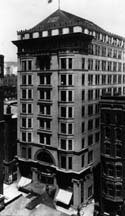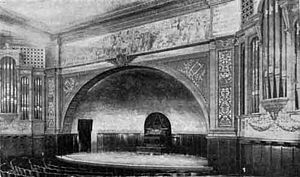Steinway Hall (Chicago) facts for kids
 |
|
| Former names | Steinway Music Hall, Ziegfeld Hall, Kelly and Leon Opera House, Whitney Opera House, Central Music Hall, Central Theatre, Minturn’s Central Theatre, Barrett’s Central Theatre, Shubert’s Central Theatre, Punch & Judy Theatre, Sonotone Theatre, Studio Theatre, Ziegfeld Theatre, Capri Cinema |
|---|---|
| Location | 64 East Van Buren Street, Chicago, IL |
| Type | Office building / Indoor theater |
| Capacity | 11-stories / 850-seat theater |
Steinway Hall was a tall building in Chicago, Illinois. It stood from 1896 to 1970. This 11-story building had offices and a theater on the ground floor. Later, the theater became a movie cinema.
The theater had many different names over the years. It started as the Steinway Music Hall in 1896. It closed in the late 1960s as the Capri Cinema. In the early 1900s, famous architects had their offices here. One of them was a young Frank Lloyd Wright. These architects were inspired by the Arts and Crafts movement and formed a group called the Prairie School.
Contents
History of Steinway Hall
Steinway Hall was an 11-story building. It was designed by Dwight H. Perkins. The building opened in 1896. The famous piano company, Steinway & Sons, built it. The theater inside was one of many Steinway Halls around the world. These halls were made to show off the company's pianos.
A Hub for Architects
Starting in 1896, the 11th floor became a meeting place for important architects. These included Dwight H. Perkins, Robert C. Spencer, Frank Lloyd Wright, and Myron Hunt. Frank Lloyd Wright kept an office there until about 1908.
Many other architects also used the building. Some of them were Webster Tomlinson, Irving Pond, Allen Bartlitt Pond, Adamo Boari, Walter Burley Griffin, and Birch Long. The building was the main spot for a group of architects called "The Eighteen." Frank Lloyd Wright gave them this name. They met for meals to talk about architecture and shared ideas. Other architects who met with the group included Arthur Dean, George Dean, Hugh Garden, Arthur Heun, Alfred Hoyt Granger, Richard E. Schmidt, and Howard Shaw.
Musical College Moves In
Around 1925, the Chicago Musical College moved into Steinway Hall. That year, 125 teachers worked there. The college even opened three floors for student dorms. The college stayed until 1954. Then, it joined with Roosevelt University's School of Music. They moved their operations to the Auditorium Building.
End of Steinway Hall
Steinway Hall was torn down in 1970. A new, much larger building was built in its place. This new building is called the CNA Center. It was built between 1970 and 1972. The CNA Center is 44 stories tall. It is easy to spot in Chicago's skyline because it is bright red.
History of the Theater
The theater inside Steinway Hall had 850 seats. It first opened as the Steinway Music Hall. By 1900, the theater was renamed Ziegfeld Hall. It was likely rented by Florenz Ziegfeld, Jr., a famous showman. Soon after, it was called the Kelly and Leon Opera House.
Changes Over Time
By 1910, the theater was known as the Whitney Opera House. It was rented by B.C. Whitney. Famous performers like Sophie Tucker and Fatty Arbuckle appeared on stage there. Around 1915, it became the Central Music Hall. It showed plays by Shakespeare. This theater should not be confused with another Central Music Hall in Chicago. That one was designed by Dankmar Adler and was torn down in 1900.
The Central Music Hall was renamed the Central Theatre in 1923. Its name changed a few more times depending on who rented it. It was called Minturn's Central Theatre, Barrett's Central Theatre, and Shubert's Central Theatre.
From Live Shows to Movies
In 1930, the theater became a movie house. It was named the Punch & Judy Theatre. Around 1931, it went back to live performances and was called the Central Theatre again. But in 1934, it started showing movies again. It was renamed the Sonotone Theatre. Later, it was called the Studio Theatre, then the Ziegfeld Theatre. Finally, in 1958, it became the Capri Cinema. The Capri Cinema showed movies until it closed in the late 1960s. The theater was torn down with the rest of the building in 1970.


